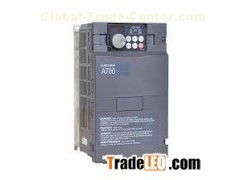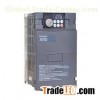The major source of problems in the real world is conducted emissions and these are typically in the region of 20kHz to 10MHz. The source of the emissions is the output of the VFD which comprises 6 solid state switches that switch each output between the DC bus rails. These switches are typically high speed IGBTs which can switch in less than 100nS.
The output waveform is a PWM waveform designed to create a sinusoidal current flow into the motor.
All VFD applications require programming. You have to make it do what you want. Parameters like minimum and maximum frequencies, number of motor poles, maximum current, overload response, braking behavior, acceleration profiles, etc. must be set by the user to match your installation's needs. The voltage/frequency curve is user configurable too, which is very useful for your kind of application where you are operating outside the normal frequency range of the motor. Good VFDs come with a display that can be set to show the motor speed (or any number of other parameters). If I were doing this, I would use a 1HP 208V two-pole motor and a 1HP VFD with a 240V input.
One feature that is present in the Mitsubishi VFD and not present in cheaper units that I have installed is a braking resistor. These are used in applications where you want to use the motor as a brake to stop the machine or control the speed of a descending load. The bigger the resistor, the quicker the stop can be programmed in. You can eliminate coasting, even under significant load, when using a resistor. A unit without this resistor built in is quite a bit smaller in size and less expensive. Often an external resistor can be added to the cheaper units if you decide you want to add one later, but at least you aren't paying for it when you don't need it.
The variable frequency drive is becoming popular in setting up 3phase powered equipment. Most of the units are capable of producing variable frequency 3 phase power from a single phase source. The downside being there is a reduction of power rating. In other words, you would need a 5-6HP VFD to run a 3HP motor if the input is single phase. Now the beauty of using a VFD inverter is your ability to control motor speed. You can crank the cycles down so that the motor is barely turning. Or if you needed more speed, that is possible as well. Maybe even to the point of speeds that are dangerous. For instance, running a 60hertz motor at 400hertz.
1hp VFD blows one of the fuses on the line side of the drive and then continues to operate on single phase supply. The fuse size that keeps blowing is a 6A fuse. This motor is a 9-lead motor which originally was wired incorrectly, which we thought was the problem, however now we have confirmed that the motor is wired correctly and it is still blowing this same phase fuse every time. I wouldn’t suspect the fuses are too small because after the fuse blows and the drive is running on single phase supply we would expect the current on the two remaining phases to increase and thus blow the other two fuses if they were marginal.
1HP VFD, 50Hz/60Hz 220V single phase input







